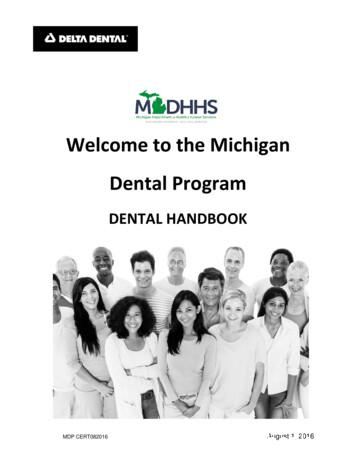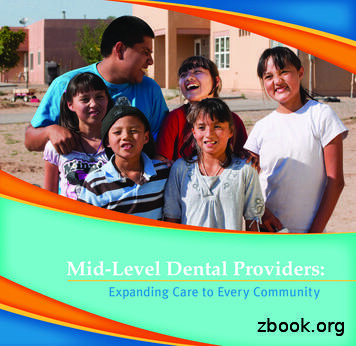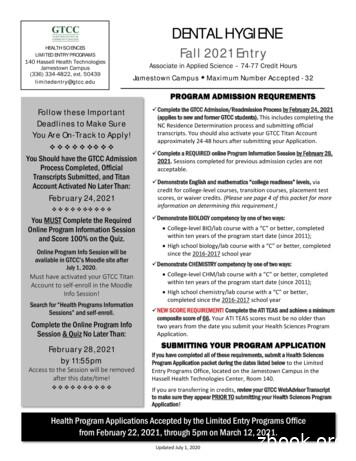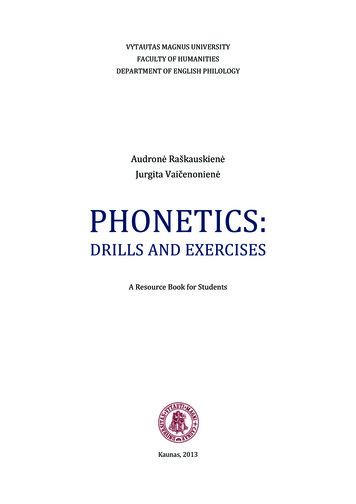Dental Record Keeping Guidlines - Az184419.vo.msecnd
1GUIDELINESApproved by Council – November 2019This document replaces theversion published in May 2008.Dental RecordkeepingThe Guidelines of the Royal College of Dental Surgeons of Ontario contain practiceparameters and standards that should be considered by all Ontario dentists in the care oftheir patients. These Guidelines may be used by the College or other bodies to determine ifappropriate standards of practice and professional responsibilities have been maintained.CONTENTSDIAGNOSIS AND TREATMENT PLANNING . . . . . . . . . . . . 7INTRODUCTION . . . . . . . . . . . . . . . . . . . . . . . . . . . . . . . . . 2 Emergency/Specific Examination for New Patients . . . 8USE OF THIS DOCUMENT . . . . . . . . . . . . . . . . . . . . . . . . . 2INFORMED CONSENT . . . . . . . . . . . . . . . . . . . . . . . . . . . . 8RECORDKEEPING BASICS . . . . . . . . . . . . . . . . . . . . . . . . 2PROGRESS NOTES . . . . . . . . . . . . . . . . . . . . . . . . . . . . . . 9GENERAL RECORDKEEPING PRINCIPLES . . . . . . . . . . . . 3 Tips for Chart Entries . . . . . . . . . . . . . . . . . . . . . . . . 9GENERAL PATIENT INFORMATION . . . . . . . . . . . . . . . . . . 3REFERRAL DOCUMENTATION . . . . . . . . . . . . . . . . . . . . . 10MEDICAL HISTORY . . . . . . . . . . . . . . . . . . . . . . . . . . . . . . 3PATIENT FOLLOW-UP AND RECALL EXAMINATIONS . . . 10 Follow-Up Questions and Review of Systems . . . . . . 4FINANCIAL RECORDS . . . . . . . . . . . . . . . . . . . . . . . . . . . 10 Recall History . . . . . . . . . . . . . . . . . . . . . . . . . . . . . . 4DRUG RECORDS . . . . . . . . . . . . . . . . . . . . . . . . . . . . . . . . 11DENTAL HISTORY . . . . . . . . . . . . . . . . . . . . . . . . . . . . . . . 4 Securely Issuing Written Prescriptions . . . . . . . . . . 12CONFIDENTIALITY AND PRIVACY . . . . . . . . . . . . . . . . . . 5RETENTION OF DENTAL RECORDS . . . . . . . . . . . . . . . . . 12COMPREHENSIVE CLINICAL EXAMINATION . . . . . . . . . . 5 Additional Considerations . . . . . . . . . . . . . . . . . . . . 12 Vital Signs . . . . . . . . . . . . . . . . . . . . . . . . . . . . . . . . . 5RELEASE AND TRANSFER OF DENTAL RECORDS . . . . . 13 Extra-Oral Evaluation . . . . . . . . . . . . . . . . . . . . . . . . 5CHANGE OF PRACTICE OWNERSHIP AND Intra-Oral Evaluation . . . . . . . . . . . . . . . . . . . . . . . . . 6SUCCESSION PLANNING . . . . . . . . . . . . . . . . . . . . . 13RADIOGRAPHIC EXAMINATION . . . . . . . . . . . . . . . . . . . . 6ADDITIONAL RECORDKEEPING REQUIREMENTS . . . . . . 14 Initial Examination for New Patients . . . . . . . . . . . . . 7APPENDICES . . . . . . . . . . . . . . . . . . . . . . . . . . . . . . . . . . 15 Recall or Returning Patients . . . . . . . . . . . . . . . . . . . 7 Appendix 1: Sample Medical History Questionnaire . 15 Radiographic Quality . . . . . . . . . . . . . . . . . . . . . . . . 7 Appendix 2: Sample Dental History Questionnaire . . 176 Crescent RoadToronto, ON Canada M4W 1T1T: 416.961.6555 F: 416.961.5814Toll Free: 800.565.4591 www.rcdso.org
2Guidelines November 2019IntroductionDentists have professional, legal and ethical responsibilities tomaintain a complete record of each patient’s dental care . Clear,accurate and up-to-date patient records are essential to thedelivery of high quality care .Patient records must be well-organized, legible, understandableand readily accessible . They remind the dentist of past andpresent conditions of the patient and treatments alreadyprovided, and they facilitate communication with otherpractitioners involved in the patient’s care . For effective continuityof care, another dentist should be able to review the recordeasily and carry on with the patient’s treatment .the treatment required . However, certain baseline data should becommon for all patients, including: accurate general patient information; a medical history that is updated regularly; a dental history; an accurate description of the conditions that are presenton initial examination, including an entry such as “withinnormal limits” when appropriate; a record of the significant findings of all supportingdiagnostic aids and tests, such as radiographs anddiagnostic study models; a diagnosis and treatment plan; a notation that informed consent was obtained from thepatient for treatment; a notation that patient consent was obtained for the releaseof any patient information to a third party;Use of This DocumentThese Guidelines are to be used by dentists in providingroutine dental care; they may not be adequate for all practice a record of all referrals to and reports from otherpractitioners a description of all treatment that is provided, materials anddrugs used, and when appropriate, the outcome of thetreatment;situations . While the examples used in this document apply an accurate financial record;primarily to general dentists, the principles relate to all dentists . a record of all communications with the patient relevant toIn all circumstances, a dentist must use reasonable professionaltheir care, including in-person conversations, call notes andjudgment to decide what modifications are necessary. Thee-mails .essential objective is safe treatment of the patient . The terms“appropriate” and “pertinent” have been used throughout theseIn addition to their content, how records are created andGuidelines to indicate when professional judgment is expectedmaintained will vary and change . Historically, dentists used paperto be used .charts and ledgers to keep records for their patients . The use ofelectronic records by dentists, including digital radiography, hasgrown substantially in Ontario .Recordkeeping BasicsAll patient records, traditional and electronic, must complywith these Guidelines . Electronic records raise additional issuesIn dentistry, a record is any item of information, regardless ofregarding accuracy, authenticity and access .form or medium, created or received by a dentist, dental office orhealth profession corporation, and maintained to provide care toFor more detailed information about the essential principlespatients and conduct business .in managing and protecting electronic records, as well as theminimum requirements of related electronic records managementThe scope of patient records will vary, depending on thesystems, refer to the College’s Guidelines on Electronic Recordsconditions with which a patient presents and the complexity ofManagement .
Dental RecordkeepingGeneral RecordkeepingPrinciples3 emergency contact name (and relationship to the patient)and telephone numbers name of the person or agency responsible for payment insurance information, if applicablePatient records must provide an accurate picture of theconditions present on initial examination, as well as the clinicaldiagnosis, treatment options, the proposed and acceptedtreatment plan, a record of the treatment performed, detailsabout any referrals, and the prognosis and/or outcome ofthe treatment when applicable . In keeping and maintainingacceptable patient records, the following principles are essential: All entries should be dated and recorded by hand inpermanent ink or typewritten, or be in an acceptableelectronic format and “locked” on the date to which they areattributed . All entries should be complete, clear and legible . All entries should be signed, initialled or otherwiseattributable to the treating clinician . Radiographs and other diagnostic aids, such as diagnosticstudy models and intra-oral photographs, should be datedand properly associated to the correct patient by name, andthe interpretation of the findings documented. An explanation of the overall treatment plan, treatmentalternatives, any risks or limitations of treatment and theestimated costs of the treatment should be provided toeach patient, parent, legal guardian or substitute decisionmaker, as appropriate, and noted in the patient record .In complex or difficult cases, consider additional signeddocumentation of informed consent .Medical HistoryTo allow for the provision of safe dental care, dentists mustensure all necessary and relevant medical information isobtained prior to initiating treatment . This information should becollected systematically, recording the patient’s present state ofhealth and any serious illnesses, conditions or adverse reactionsin the past that might affect the dental management of thepatient . In particular, the following key areas must be addressedfor all patients: history of any cardiovascular disease or condition history of any immuno-compromising disease or condition known allergies or adverse reactions a list of all current medications, including dosage details of past hospitalizations and/or serious illnesses current pregnancy or breastfeedingA medical history form, questionnaire or system shouldadequately reflect the dentist’s practice. It should be comprisedof a reasonable set of questions to assist the dentist in obtainingthe necessary information from the patient to determine if dentalprocedures can be performed safely .The design of a medical history questionnaire must provideGeneral Patient Informationsufficient space to initially record all relevant information. Inaddition, it must allow for a positive or negative response by thepatient to each of the questions . Consider including a not sure/Patient records must contain the following general information,maybe response, which allows the patient to convey uncertainty .which must be updated regularly:See Appendix 1 for a sample medical history questionnaire . patient name, address and contact information, includingtelephone numbers (home, work, mobile) and emailFor more detailed information, see the College’s Medical Historyaddresses (optional)Recordkeeping Guide . date of birth name, address and contact information of the patient’sphysician (or other primary family health care provider) andany medical specialists name, address and contact information of any referringhealth care professional, if applicableOnce completed, the medical history questionnaire shouldbe reviewed, dated and signed by the treating dentist andupdated regularly. In addition, the dentist should have thecompleted form signed by the patient, parent, legal guardian orsubstitute decision-maker.
4Guidelines November 2019FOLLOW-UP QUESTIONS AND REVIEW OFSYSTEMS When was your last medical checkup? Were any problems identified? If yes, please explain. Are you breastfeeding or pregnant? If pregnant, what is theA medical history questionnaire is only a starting point to obtainexpected delivery date?information from the patient; it must be reviewed and interpretedby the treating dentist to determine if enough information hasA dentist may choose to have the patient complete anbeen obtained to provide safe dental care .abbreviated recall history questionnaire . A sample form isprovided with the accompanying materials to the Medical HistoryAdditional information may be obtained through discussion withRecordkeeping Guide .the patient to clarify any positive or unclear responses beforeinitiating care . Responses that indicate a potentially seriousAt some point, the accumulation of changes to the medicalmedical condition may warrant follow-up with an appropriateinformation or the simple passage of time may suggest to thereview of the system affected (ROS), which must be clearlydentist that the patient should complete a new medical historydocumented . A history of heart attack, for instance, mayquestionnaire . Reasonable clinical judgment must be used tonecessitate a review of the cardiovascular system . Additionaldetermine when this is appropriate .information may also be obtained by conducting an appropriatephysical examination of the head, neck and intra-oral cavity, thetaking and recording of vital signs, such as heart rate and bloodpressure, and/or consultation with the patient’s present and priorhealth care providers .Any drug allergies and any significant illnesses or conditionsthat are pertinent to the patient’s care should be conspicuouslynoted within the patient record.Sensitive personal health information must NOT be recorded onthe exterior of a patient’s chart . Instead, a coded system (e .g .colour-coded stickers) may be used to alert relevant dental staff .RECALL HISTORYThe patient’s medical information should be reviewed andupdated regularly to ensure that it remains accurate . The dentistmay have the patient review the information previously obtainedand advise of any changes, or the dentist may ask specificquestions of the patient . In either case, the results of the inquiryDental HistoryIn addition to the medical history, the patient record must noteany significant dental history. Information obtained regarding apatient’s dental history can supplement the clinical examination,and assist in planning and sequencing of dental care .Specific habits and/or risk factors should be identified, such asoral hygiene practices or parafunction, which may have an impacton future treatment planning . If not already captured by themedical history, a family and social history should be includedwith questions regarding use of tobacco and related products(e .g . e-cigarettes), alcohol consumption, recreational drug use(e .g . cannabis), and hobbies and other interests .Checklists and/or short-answer questions may be used to obtaininformation about the patient’s dental history . See Appendix 2 fora sample dental history questionnaire .must be clearly documented .Appropriate questions include: Has there been any change in your health, such as anyThe patient record should contain statements,identifying the immediate need or chief complaint, aswell as its history, as presented by the patient.serious illnesses, hospitalizations or new allergies? If yes,please explain . Are you taking any new medications or has there been anychange in your medications? If yes, please explain . Have you had a new heart problem diagnosed or had anychange in an existing heart problem?Another good way to obtain information is with “MotivationalInterviewing” . This uses a collaborative approach in which thedentist asks open-ended questions to reveal and understand thepatient’s needs and priorities . Examples include:
Dental Recordkeeping4 What is important to you about your oral health?Patient records must be stored securely, not left unattended or4 How can our office help you achieve your oral healthin public areas of the office, and destroyed appropriately andpriorities and treatment expectations?4 What are the most important qualities of a dental practice5securely at the end of the required retention period (see sectionon Retention of Dental Records .)for you? How can we best accommodate your needs?4 Do you identify as a person with a disability or as a DeafIf personal health information is lost, stolen or accessed byperson? If yes, how may we best assist you in our dentalunauthorized persons, health information custodians mustpractice?notify the affected patients at the first reasonable opportunity.4 Is there anything else we should know regarding yourIn addition, health information custodians must notify thepast dental history, including any specific concerns orInformation and Privacy Commissioner about certain privacyproblems (financial, scheduling etc.)?breaches .For more detailed information, refer to the Personal HealthConfidentiality and PrivacyPatients reveal, and patient records contain, sensitive personalhealth information . Health care providers, including dentists,have professional, legal and ethical responsibilities to keep theirInformation Protection Act, 2004, and the regulations madeunder the Act, available on the website of the Information andPrivacy Commissioner at www .ipc .on .ca . Also see the College’sdocument on Compliance with Ontario’s Personal HealthInformation Protection Act .patients’ personal health information confidential and private.Ontario’s Personal Health Information Protection Act, 2004 1(PHIPA) sets out legal obligations for health informationcustodians, including dentists, to ensure that the privacy of theirpatients’ personal health information is protected .A dentist is responsible for ensuring that all staff and otheragents acting on their behalf are aware of requirements formaintaining confidentiality with respect to a patient’s personalhealth information. Specifically, a dentist is responsible forensuring that they only collect, use and disclose personal healthinformation with the consent of the patient or as permitted orrequired by PHIPA .A dentist is also responsible under PHIPA to take steps thatare reasonable in the circumstances to ensure that recordsof personal health information in their custody or control areretained, transferred and disposed of in a secure manner . Inparticular, health information custodians must ensure that recordsof personal health information in their custody or control areprotected against theft, loss and unauthorized use or disclosure,and to ensure that the records containing the informationare protected against unauthorized copying, modification ordisposal .Comprehensive ClinicalExaminationPatient records should include descriptions of the conditions thatare present on examination .VITAL SIGNSRelevant vital signs may include pulse, blood pressure,oxyhemoglobin saturation (via pulse oximetry), respiration andtemperature . The need to measure and record vital signs willdepend on the patient’s age, medical history, level of anxiety,the nature and complexity of forthcoming dental treatmentand whether the use of sedation or general anesthesia iscontemplated .EXTRA-ORAL EVALUATION1 .2.General Survey: Height, weight, posture, mobility .Limbs and Extremities: Skin, joints, finger nails, presence ofclubbing, tremors, lesions, scars, other abnormalities .3 .Head and Neck: Symmetry, movement, skin, lymph nodes,sinuses, muscles of mastication and orofacial region, thyroid,temporomandibular joint, salivary glands .1S .O . 2004, c .3, Sched . A .
6Guidelines November 2019INTRA-ORAL EVALUATIONAs part of a comprehensive clinical examination, it is importantto document in the patient record that each of these areas1 .2 .Soft Tissues: Lips and labial mucosa, buccal and vestibularhas been addressed during the examination . For those areasmucosa, hard and soft palates, oropharynx and fauces,demonstrating an absence of abnormality or anomaly, notationstongue, floor of the mouth.such as “within normal limits” or “no significant findings” may beHard Tissues: Bone structure, asymmetry, abnormality,recorded .growth, presence of tori/exostoses, ridge form .3 .Dentition: The evaluation of the teeth should be recordedThe odontogram must be large enough and/or have the abilityby means of an odontogram and/or a list of clinical findingsto allow for the charting of all pertinent clinical findings. Oncefor each tooth . If applicable, the following areas should becompleted, the odontogram establishes a permanent record ofaddressed:the patient’s initial conditions and, therefore, must not be altered .a . Missing and Misplaced Teeth: Congenitally missing,extracted, unerupted, impacted teeth, tipping, drifting,Changes in clinical findings noted at subsequent re-examinationrotation .or emergency appointments should be rec
Appendix 1: Sample Medical History Questionnaire . 15 Appendix 2: Sample Dental History Questionnaire . . 17. 6 Crescent Road Toronto, ON Canada M4W 1T1 T: 416.961.6555 F: 416.961.5814 Toll Free: 800.565.4591 www.rcdso.org
DENTAL SCIENCES 1 Chapter 1 I Dental Assisting— The Profession 3 The Career of Dental Assisting 4 Employment for the Dental Assistant 4 The Dental Team 6 Dental Jurisprudence and Ethics 12 Dental Practice Act 12 State Board of Dentistry 12 The Dentist, the Dental Assistant, and the Law 13 Standard of Care 13 Dental Records 14 Ethics 14
Cigna Dental Care DMO Patient Charge Schedules 887394 09/15 CDT 2016 Covered under Procedure Code1 Dental Description and Nomenclature Cigna Dental 01 and 02 PCS Cigna Dental 03 PCS Cigna Dental 04 PCS Cigna Dental 05 PCS Cigna Dental 06 PCS Cigna Dental 07 PCS Cigna Dental 08 PCS Chair Time Per Y/N Minutes Code # (if different) Y/N Code # (if .
is a detailed list of dental services provided by a dental office and given to Delta Dental for payment. Delta Dental means Delta Dental Plan of Michigan, Inc., a service provider for dental benefits under the Michigan Dental Program. Delta Dental ID Card is a permanent (not monthly) card. We send
Mid-level dental providers, variously referred to as dental therapists, dental health aide therapists and registered or licensed dental practitioners, work as part of the dental team to provide preventive and routine dental services, such as cleanings and fillings. Similar to how nurse practitioners work alongside physicians, mid-level dental .
Jun 14, 2016 · active duty Soldiers treated at any of five dental clinics on Fort Bragg. These clinics included Davis Dental Clinic, Joel Dental Clinic, LaFlamme Dental Clinic, Pope Dental Clinic, and Smoke Bomb Hill Dental Clinic. For each appointment the appointment type, date, and dental wellness class
DEN 131 Dental Hygiene Clinic 1 3 credits . Summer 2022. DEN 125 Dental Office Emergencies 1 credit DEN 140 Dental Hygiene Theory 2 1 credit DEN 141 Dental Hygiene Clinic 2 2 credits DEN 222 General and Oral Pathology 2 credits . Fall 2022. DEN 123 Nutrition/Dental Health 2 credits DEN 220 Dental Hygiene Theory 3 2 credits DEN 221 Dental .
Dental Blue for Individuals. SM - a consumer-driven dental plan for individuals and their eligible dependents . Dental Blue for Seniors. SM - a consumer dental product for individuals and their spouse age 65 and older . Dental Blue For Federal Employee Program - offers federal employees a dental supplemental plan to
The present resource book is designed as a supplement to Peter Roach’s (2010) textbook English Phonetics and Phonology: A Practical Course and may be used to accompany lecture courses on English Phonetics at university level. It is equally suitable for self‐study and for in‐class situation























